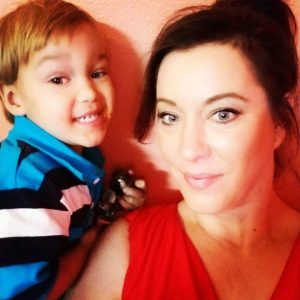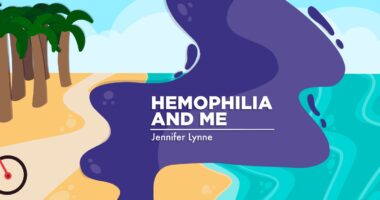Female Focus: Brandi’s Story Through Pregnancy and Childbirth

Brandi’s journey with hemophilia
Recently, I had the opportunity to speak with Brandi Worthington about her experiences as a woman living with hemophilia. Brandi was in her 30s when she received a diagnosis that linked hemophilia to her long-standing bleeding issues. This revelation came 23 years after the onset of her first significant bleeding episodes. Her journey has at times been harrowing.
As a child, Brandi bruised easily. She bled for hours after dental work and kept gauze dressings in place to stop her gums from bleeding. She started menstruating at age 11 and believed the large blood clots and significant blood loss she experienced were normal because it was all she knew.
Undiagnosed and in danger
During the first month of Brandi’s first pregnancy, she was in a horrific accident: A drunk driver ran her over and dragged her for 80 feet. She suffered 17 fractures, including her femur, ribs, tailbone, and pelvis.
Her injuries affected her ability to have a natural birth, so she was scheduled for a cesarean section at 39 weeks. During most of her pregnancy, she struggled with ongoing severe pain, primarily on her left side. Brandi describes it as though someone was stabbing her. However, she says doctors dismissed her concerns, telling her that they were “normal pregnancy pains.” She didn’t know enough at the time to question their assessment.
She began to experience labor contractions at 37 weeks. Doctors stopped her contractions four times because they wanted to delay until her scheduled C-section. When her baby finally was delivered, Brandi says the surgeon was shocked to find an infected softball-sized blood clot next to the baby. During surgery to remove the clot, she lost most of her left fallopian tube.
Her subsequent two babies were delivered via C-section. She bled for two months straight after one C-section. Following each of her three births, Brandi felt ill, lost considerable amounts of weight, and became pale with dark shadows under her eyes.
Brandi believes that if she had a hemophilia diagnosis and had received factor after her accident, she could have avoided complications during her pregnancy. At the time, Brandi did not think to ask for testing for hemophilia as the only people she knew with the disorder were male.
Following the birth of her twin sister’s baby and subsequent diagnosis with hemophilia, doctors tested Brandi’s baby boy but neglected to test her for the condition. Eventually, during her third pregnancy, Brandi received a diagnosis of hemophilia A with factor levels low enough to be considered a woman with mild hemophilia — 5-40 percent of the normal amount of clotting factor — under internationally recognized guidelines. She has never received factor replacement products, even when having a C-section post-diagnosis, despite recommendations by the National Hemophilia Foundation’s Medical and Scientific Advisory Council that pregnant women with hemophilia A or B whose factor levels are under 50 percent should receive factor replacement at the time of delivery.
Lyonization in action
Brandi is an identical twin and her sister also has hemophilia. Their factor levels are significantly different, with Brandi’s almost double those of her sister. This is due to the lyonization, or X-chromosome inactivation that occurs in utero after the eggs have split. When their duplicate chromosomes turned off, Brandi’s sister had more mutated chromosomes remain than Brandi did, resulting in lower factor levels.
What doctors should know
Brandi wants medical professionals to know that women can have hemophilia just like men. She wants them to understand that, “We are NOT symptomatic carriers, we are mild, moderate, and severe hemophiliacs. We exhibit the same signs. We are in danger; a woman can die in childbirth without proper treatment. We are women with hemophilia.”
She believes lack of knowledge is the greatest barrier to treatment. She experienced an immense sense of relief when she was finally diagnosed. Her wish is for every medical clinic to have a chart on its walls listing the signs and symptoms of bleeding disorders in women. She wants to see awareness grow so that more women will be tested for bleeding disorders and she hopes that in the future men and women with hemophilia will be treated equally.
Undiagnosed hemophilia has led to her living with chronic pain from repeated untreated injuries. Brandi wants to spare other women the struggles that lack of diagnosis and treatment have caused her.
Thank you, Brandi Worthington, for allowing me to share your story.
***
Note: Hemophilia News Today is strictly a news and information website about the disease. It does not provide medical advice, diagnosis, or treatment. This content is not intended to be a substitute for professional medical advice, diagnosis, or treatment. Always seek the advice of your physician or another qualified health provider with any questions you may have regarding a medical condition. Never disregard professional medical advice or delay in seeking it because of something you have read on this website. The opinions expressed in this column are not those of Hemophilia News Today or its parent company, Bionews Services, and are intended to spark discussion about issues pertaining to hemophilia.








Susan Inwood
Thank you for sharing your story. I also have Haemophilia A-with levels of 30%. I bled on the table after my second son was born and remember the dripping sounds even after 31 years. For years I have told GP and specialists that women are not taken seriously enough-but all to no avail. When the World Haemophilia Foundation reported that woman can have Haemophilia and are not just carriers I proudly took this to my GP- who still didn't take it seriously. I wish you all the best for your future life and send peace and sunshine from New Zealand x